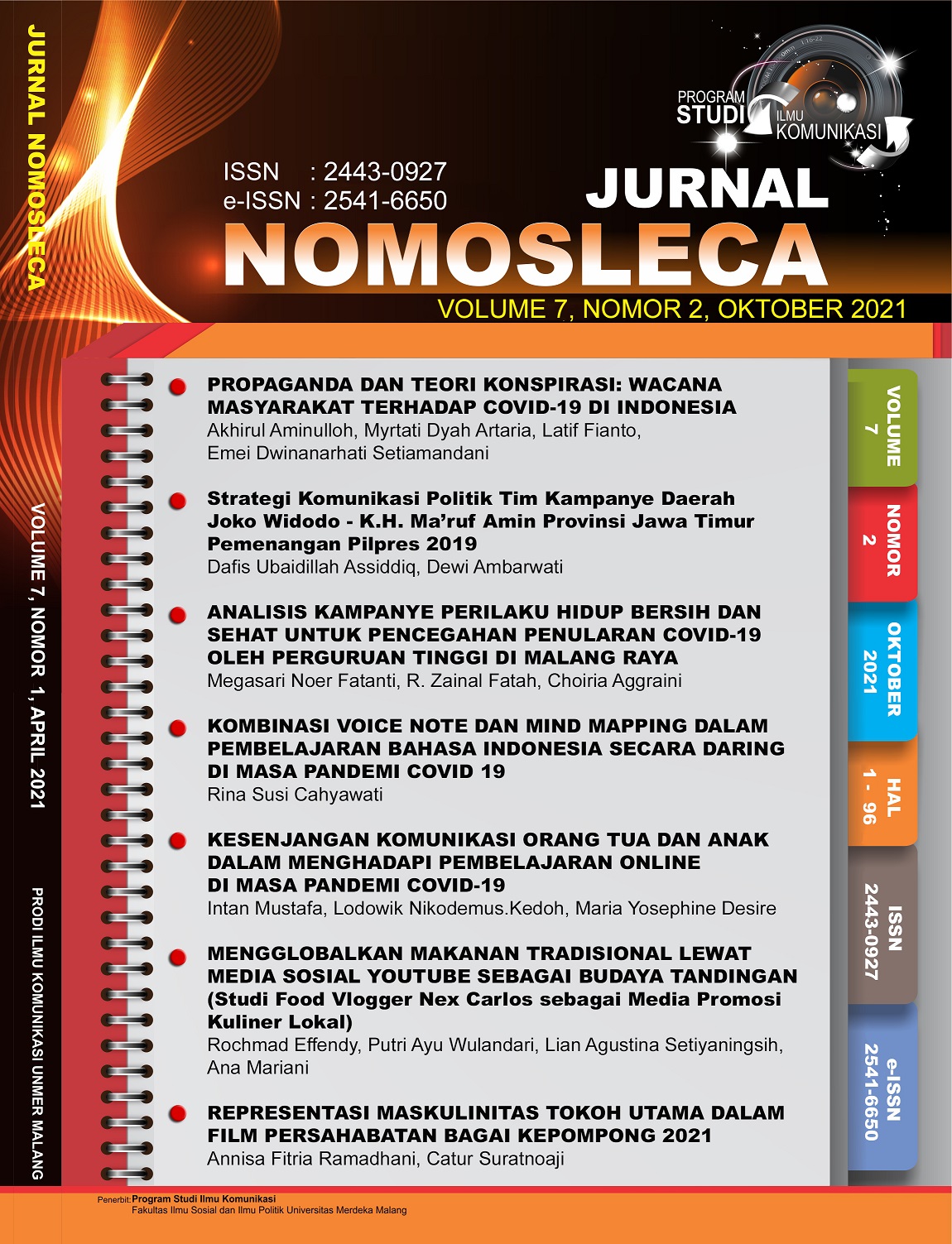Propaganda dan Teori Konspirasi: Wacana Masyarakat terhadap Covid-19 di Indonesia
DOI:
https://doi.org/10.26905/nomosleca.v7i2.5821Abstract
Â
The conspiracy theory allows non-existent information to be exist. Likewise with propaganda which causes information to roll without being able to ascertain its correctness because its purpose is to manipulate public opinion. This study aims to see the complexity of the fight against the Covid-19 discourse in Indonesian society. This study used a qualitative method with a critical discourse analysis approach. Data collection was obtained from online media and social media, especially Twitter in the April 2020 period. The data were analyzed by using the Critical Discourse Analysis model of Fairclough. The result of this study indicated that it was not enough for the Covid-19 outbreak to be reported as a natural virus, but to be explored into a controversial discourse in the form of a conspiracy theory. The propaganda of the Covid-19 conspiracy theory was carried out through social media. Belief in conspiracy theory was caused by three things, they were people needed definite and reasonable answer to the phenomenon of the Covid-19 pandemic, they wanted to have control over their lives, and the impact of Post Truth era.
Â
Keywords: Propaganda, Conspiracy Theory, Discourse, Covid-19
Downloads
References
Brennan, J. (2017). Propaganda about Propaganda. Critical Review, 29(1), 34–48. https://doi.org/10.1080/08913811.2017.1290326
Brown, É. (2018). Propaganda, Misinformation, and the Epistemic Value of Democracy. Critical Review, 30(3–4), 194–218. https://doi.org/10.1080/08913811.2018.1575007
Creswell, W. J. (2009). Research Desain: Qualitative, Quantitative, and Mixed Methods Approaches (3rd editio). SAGE Publication.
Dhama, K., Sharun, K., Tiwari, R., Dadar, M., Malik, Y. S., Singh, K. P., & Chaicumpa, W. (2020). COVID-19, an emerging coronavirus infection: advances and prospects in designing and developing vaccines, immunotherapeutics, and therapeutics. In Human Vaccines and Immunotherapeutics (pp. 1–13). https://doi.org/10.1080/21645515.2020.1735227
Douglas, K. M., Uscinski, J. E., Sutton, R. M., Cichocka, A., Nefes, T., Ang, C. S., & Deravi, F. (2019). Understanding Conspiracy Theories. Political Psychology, 40(1), 1–35. https://doi.org/10.1111/pops.12568
Eriyanto. (2009). Analisis Wacana: Pengantar Analisis Teks Media. LKiS.
Eyal, J. (2020). Fatal attraction: The rise of Covid-19 conspiracy theories. Straitstimes.Com.
Fahmi, I. (2020). Teori Konspirasi dan Waras Bermedsos. Pers.Droneemprit.Id/.
Franedya, R. (2020). Covid-19 Senjata Biologis & Teori Konspirasi Viral Lainnya. Cnbcindonesia.Com.
Hadiwardoyo, W. (2020). Kerugian Ekonomi Nasional Akibat Pandemi Covid-19. Baskara Journal of Business and Enterpreneurship, 2(2), 83–91. https://doi.org/10.24853/baskara.2.2.83-92
Halim, D. (2020). 6 Bulan Pandemi Covid-19: Hoaks dan Teori Konspirasi yang Memperparah Penanganan... Kompas.Com.
Haryanto, A. T. (2020). Ilmuwan Klaim Virus Corona Berasal dari Meteor Luar Angkasa. Detik.Com.
Heins, V. (2007). Critical theory and the traps of conspiracy thinking. Philosophy & Social Criticism, 33(7), 787–801. https://doi.org/10.1177/0191453707081675
Ižák, Š. (2020). Conspiracy theory as a working method of political propaganda. Slovak Journal of Political Sciences, 20(1), 76–97. https://doi.org/10.34135/sjps.200104
Klein, C., Clutton, P., & Dunn, A. G. (2019). Pathways to conspiracy: The social and linguistic precursors of involvement in Reddit’s conspiracy theory forum. In PLoS ONE (Vol. 14, Issue 11). https://doi.org/10.1371/journal.pone.0225098
Korta, S. M. (2018). Fake News, Conspiracy Theories, And Lies: An Information Laundering Model For Homeland Security. University of Wisconsin–Madison.
Mahardhika, A. (2020). 5 Teori Konspirasi Paling Heboh Seputar Virus Corona. Detik.Com.
Marmura, S. M. E. (2014). Likely and unlikely stories: Conspiracy theories in an age of propaganda. International Journal of Communication, 8, 2377–2395.
Maulana, A. M. R. (2020). Pandemi dalam WorldviewIslam; Dari Konsepsi ke Konspirasi. Tribakti: Jurnal Pemikiran Keislaman, 31(3), 307–323. https://doi.org/10.33367/tribakti.v31i2.1232
McLoughlin, L., Ward, S., & Lomas, D. W. B. (2020). ‘Hello, world’: GCHQ, Twitter and social media engagement. Intelligence and National Security, 35(2), 233–251. https://doi.org/10.1080/02684527.2020.1713434
Moore, A. (2016). Conspiracy and Conspiracy Theories in Democratic Politics. Critical Review, 28(1), 1–23. https://doi.org/10.1080/08913811.2016.1178894
Muller, R. T. (2020). COVID-19 Brings a Pandemic of Conspiracy Theories. Psychologytoday.Com.
Nwy/erd. (2020). 5 Fakta Siti Fadilah yang Blak-blakan soal Konspirasi dan Corona. Detik.Com.
Obi-Ani, N. A., Anikwenze, C., & Isiani, M. C. (2020). Social media and the Covid-19 pandemic: Observations from Nigeria. Cogent Arts and Humanities, 7(1), 1–15. https://doi.org/10.1080/23311983.2020.1799483
Rahadian, L. (2020). Kondisi ekonomi memburuk, warga di kota paling terdampak. Lokadata.Id.
Ram, S. (2020). Coronavirus Research Trends: A 50–Year Bibliometric Assessment. Science and Technology Libraries, 39(2), 210–226. https://doi.org/10.1080/0194262X.2020.1742270
Savrum, M. Y., & Miller, L. (2015). The Role of the Media in Conflict, Peacebuilding, and International Relations. International Journal on World Peace, 2(3), 1–12.
Setiyaningsih, L. A., & Jatmikowati, S. H. (2019). Media Baru Dalam Komodifikasi Waktu Luang Ibu Rumah Tangga. ETTISAL: Journal of Communication, 4(1), 23–32.
Setiyaningsih, L. A. (2020). MEDIA PANICS IBU RUMAH TANGGA SETELAH MENGAKSES BERITA COVID-19 (2020). Jurnal Nomosleca, 6(2), 101–110. http://jurnal.unmer.ac.id/index.php/n/article/view/4721/2594
Shereen, M. A., Khan, S., Kazmi, A., Bashir, N., & Siddique, R. (2020). COVID-19 infection: Origin, transmission, and characteristics of human coronaviruses. In Journal of Advanced Research (pp. 91–98). https://doi.org/10.1016/j.jare.2020.03.005
Stempel, C., Hargrove, T., & Stempel, G. H. (2007). MEDIAU SE, SOCIAL STRUCTURE, AND BELIEF IN 9/11 CONSPIRACY THEORI. J&MC Quarterly, 84(2), 353–372.
Sturm, T., & Albrecht, T. (2021). ‘Constituent Covid-19 apocalypses: contagious conspiracism, 5G, and viral vaccinations.’ Anthropology and Medicine, 28(1), 122–139. https://doi.org/10.1080/13648470.2020.1833684
Svensson, E. M., & Edström, M. (2016). Market-Driven challenges to freedom of expression and the interaction between the state, the market, and the media. Nordicom Review, 37(2), 1–16. https://doi.org/10.1515/nor-2016-0013
Tribuana, L. (2020). 4 Pernyataan Kontroversi Jerinx SID soal Covid-19. Okezone.Com.
Waterson, J., & Hern, A. (2020). At least 20 UK phone masts vandalised over false 5G coronavirus claims. Theguardian.Com.
Yu, M., Li, Z., Yu, Z., He, J., & Zhou, J. (2020). Communication related health crisis on social media: a case of COVID-19 outbreak. In Current Issues in Tourism (p. 1—7). https://doi.org/10.1080/13683500.2020.1752632
Downloads
Additional Files
Published
Issue
Section
License

This work is licensed under a Creative Commons Attribution-ShareAlike 4.0 International License.





